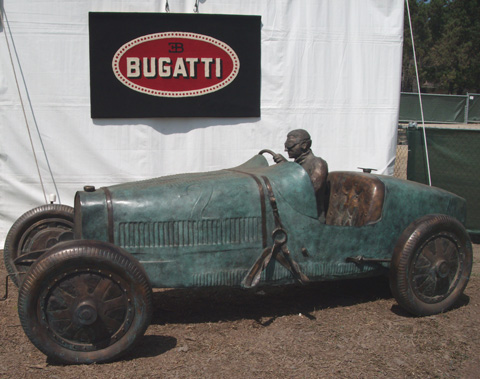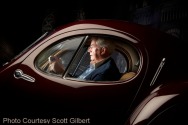 Bugatti sculpture in front of Mullin museum display at Retroauto, Pebble Beach 2009. Photo by Petya Elitch.
Bugatti sculpture in front of Mullin museum display at Retroauto, Pebble Beach 2009. Photo by Petya Elitch.
Exclusive story by Brandes Elitch
There are always a few surprises at the Monterey Historics, and this year was no exception. A few years previously, a very large tent appeared at the Equestrian Center at Pebble Beach, called Retroauto, a collection of about forty vendors of automobilia-artwork, posters, books, models, all the things that you would absolutely need to have if you hit the lottery and had the room to put them. This year, a new tent appeared next door, with two Bugattis inside, cars never before seen in the US. The display announced a new museum opening next year, founded by Peter Mullin. It will be located in Oxnard, CA, in the 46,000 square foot building which was previously home to the Otis Chandler museum. This is big news for anyone who is interested in these “grandes routieres,” because it will feature over 100 cars from the golden age of French design. There will also be French racing cars of the period. I am not aware of a similar museum anywhere else with this focus, including France.

Peter W. Mullin
Of particular interest is the fact that Mr. Mullin recently completed the purchase of some cars in storage awaiting restoration at the Schlumpf museum in eastern France, near the German border. This is a fascinating story that deserves its own article, but there has been a new development. For 30 years,
historians wrote that some of the money used to amass that huge collection (the largest collection of Bugattis in the world) was acquired by raiding the pension funds of the workers in the textile mills owned by the Schlumpfs. However, the Mullin museum indicated that after decades of legal battles, the heirs of the Schlumpfs prevailed in French court and were awarded the unrestored vehicles (but not any other cars, apparently). Mr. Mullin has purchased the complete collection, which he calls the “Schlumpf Reserve Collection.” These cars were in storage for the last three decades, and will be preserved the way that they are now.
To give you an idea of what transpired at the Schlumpf museum, here is a quote from the preface written by famous Bugatti historian Hugh Conway to the book “The Schlumpf Obsession,” by Denis Jenkinson (Doubleday, Garden City, NY, 1978): “The story of the Schulmpf collection is almost unbelievable, stranger indeed than fiction…The most difficult assessment to make is of the museum itself: fascinating, remarkable, unique, it is, without question, well worth seeing. It is also vulgar and lacking in taste. It reminds the visitor of a nouveau riche extravaganza. A museum should have a message…It should have some sort of balance in its exhibits…It should display its wares so that the visitor can get as much as possible out of his visit…” Of course, the Schlumpf museum has changed since that was written, but Mr. Conway was right on target in his initial observations. There is no doubt that Mr. Mullin will provide an entirely different kind of museum experience than Hans and Fritz did.
After purchasing the Otis Chandler museum building, Mr. Mullin has embarked on an extensive remodeling program, including a roof garden, theater, archives, gift shop, etc. The focus is on constructing a “green” building, which includes a photovoltaic roof system which will provide all the energy needed by the facility. The museum will also include art from 1800 through the Art Deco period, and will show the relationship between automobile design and various contemporary art movements of this period. This will include furniture designed by Carlo Bugatti, and art deco furnishings, paintings, etc. (Incidentally, if you want to learn more about this, you can search for a book published by the Cleveland Art Museum, “Bugatti,” University of Washington Press, Seattle, 1999, which is a definitive book on this subject).
The Mullin museum sounds like a very exciting project. There is one other spectacular car museum just outside of Los Angeles: the Nethercutt museum. Together, these museums are absolutely compelling to any serious car enthusiast, not just because of the quality of the permanent exhibit, but because, as Mr. Conway has written, of their complete and absolute focus on a theme, in Mr. Mullin’s case French cars of the Art Deco period, and in Mr. Nethercutt’s case, the cars of the classic era.
For more information about the museum, you may visit its website: www.mullinautomotivemuseum.com/
For an in-depth look at the Schlumpf Museum in VeloceToday by editor at large Lorenzo Marchesini:
Introduction to the Schlumpf
Italian Cars at the Schlumpf
French Cars at the Schlumpf